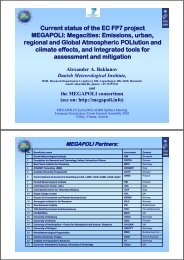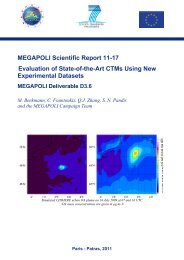D E S C R I P T I O N O F W O R K - MEGAPOLI - Dmi
D E S C R I P T I O N O F W O R K - MEGAPOLI - Dmi
D E S C R I P T I O N O F W O R K - MEGAPOLI - Dmi
You also want an ePaper? Increase the reach of your titles
YUMPU automatically turns print PDFs into web optimized ePapers that Google loves.
<strong>MEGAPOLI</strong> 212520<br />
where large megacities are expected to develop and global warming is expected to have large<br />
impacts.<br />
This WP will take as a basis the fields of constituents calculated and analysed in WP5 and use these<br />
within global and regional climate models to quantify the climate impacts. Additional studies will<br />
use the same emission fields as in WP5, but simulate the constituent fields in interactive mode with<br />
the climate and atmospheric composition evolving together. The constituent concentrations will<br />
have been evaluated in WP5, but additional evaluation will take place in this WP to compare the<br />
radiative forcings and aerosol optical properties against measurements. On both scales (global and<br />
regional) the WP will focus on the climate effects from both direct aerosol/gas-radiation interaction<br />
and indirect aerosol/gas-cloud interactions. WP6 will also provide meteorological driving fields for<br />
future climate conditions to WP5. Finally, the climate impacts of well-mixed greenhouse gases<br />
(e.g., CO2) emitted from megacities will be quantified using simple analytical formulae<br />
(Ramaswamy et al., 2001).<br />
WP7: Integrated Tools and Implementation<br />
Overview and Background<br />
Processes involving nonlinear interactions and feedbacks between emissions, chemistry and<br />
meteorology require coherent and robust approaches using integrated/online methods. This is<br />
particularly important where multiple spatial and temporal scales are involved with a complex<br />
mixture of pollutants from large sources, as in the case of megacities. The impacts of megacities on<br />
the atmospheric environment are tied directly to anthropogenic activities as sources of air pollution.<br />
These impacts act on urban, regional and global scales. Currently, there are only limited attempts to<br />
integrate this wide range of scales for regional and global air quality and climate applications.<br />
Indeed, progress on scale and process interactions has been limited because of the tendency to focus<br />
mainly on issues arising at specific scales. However the inter-relating factors between megacities<br />
and their impacts on the environment rely on the whole range of scales and thus should be<br />
considered within an integrated framework bringing together the treatment of emissions, chemistry<br />
and meteorology in a consistent modelling approach. Numerical weather and air pollution<br />
prediction models are now able to approach urban-scale resolution, as detailed input data are<br />
becoming more often available. As a result the conventional concepts of down- (and up-) scaling for<br />
air pollution prediction need revision along the lines of integration of multi-scale meteorological<br />
and chemical transport models. <strong>MEGAPOLI</strong> aims at developing a comprehensive integrated<br />
modelling framework usable by the research community which will be tested and implemented for a<br />
range of megacities within Europe and across the world to increase our understanding of how large<br />
urban areas and other hotspots affect air quality and climate on multiple scales.<br />
Methodology and Advancement Beyond the State-of-the-Art<br />
The integration strategy in <strong>MEGAPOLI</strong> will not be focused on any particular meteorological and/or<br />
air pollution modelling system. The approach will consider an open integrated framework with<br />
flexible architecture (module/interface structure) and with a possibility of incorporating different<br />
meteorological and chemical transport models. Such a strategy will be made possible through<br />
jointly agreed specifications to interface the modules for easy-to-use integration. The modules<br />
which have to be considered, include input data such as emissions, meteorological and chemical<br />
transport calculations. The structure of the framework will enable the coupling across the whole<br />
range of scales by minimizing the scale-dependence of the interfaces. This multi-scale approach is<br />
especially crucial for an efficient integration strategy. Indeed, atmospheric flows include frequently<br />
locally forced features, which interact with regional- and global-scale processes such as fronts and<br />
convection. Then, scale interaction is a challenge for both weather and air pollution predictions,<br />
especially at regional scales. Depending on both time and space scales, certain atmospheric<br />
23




